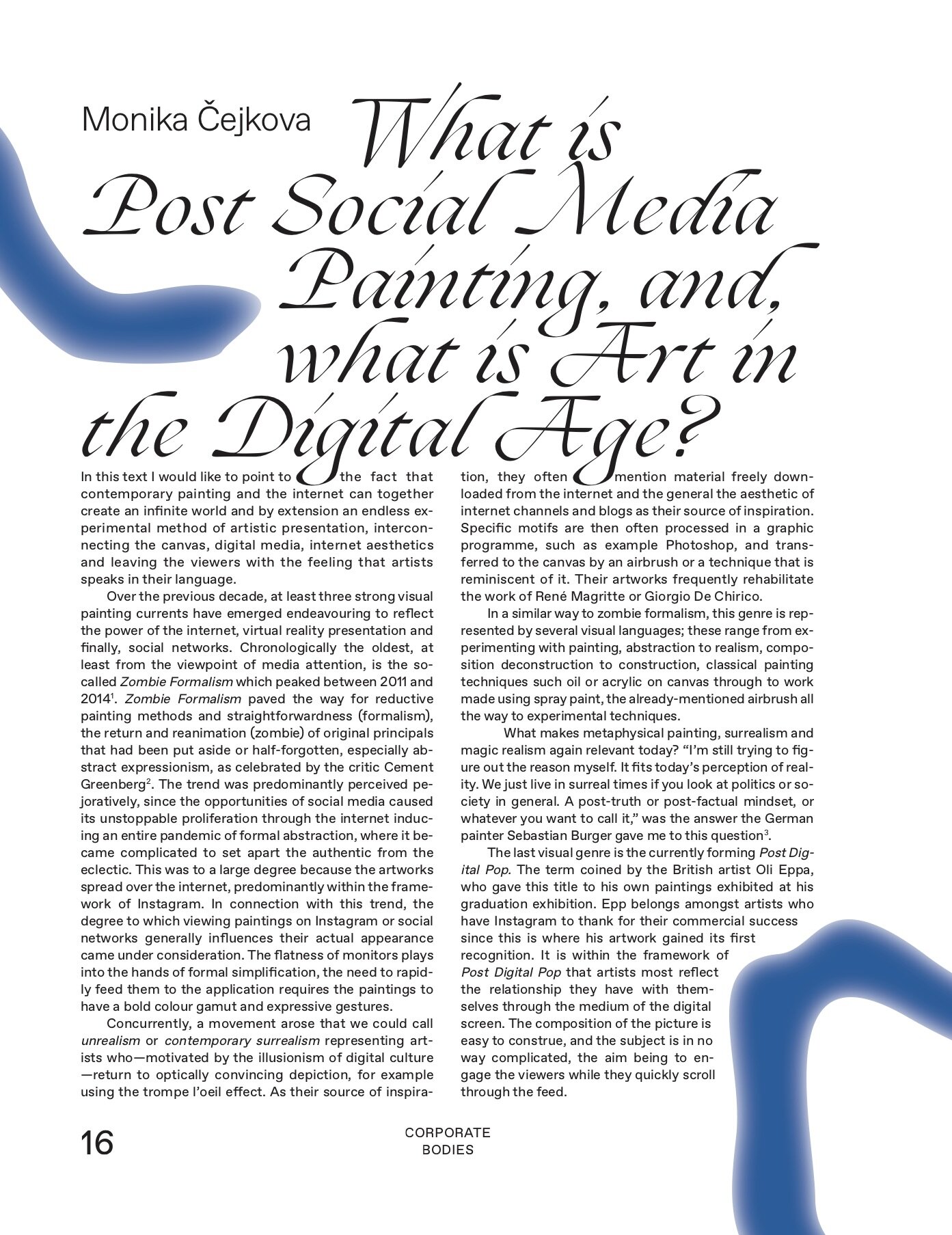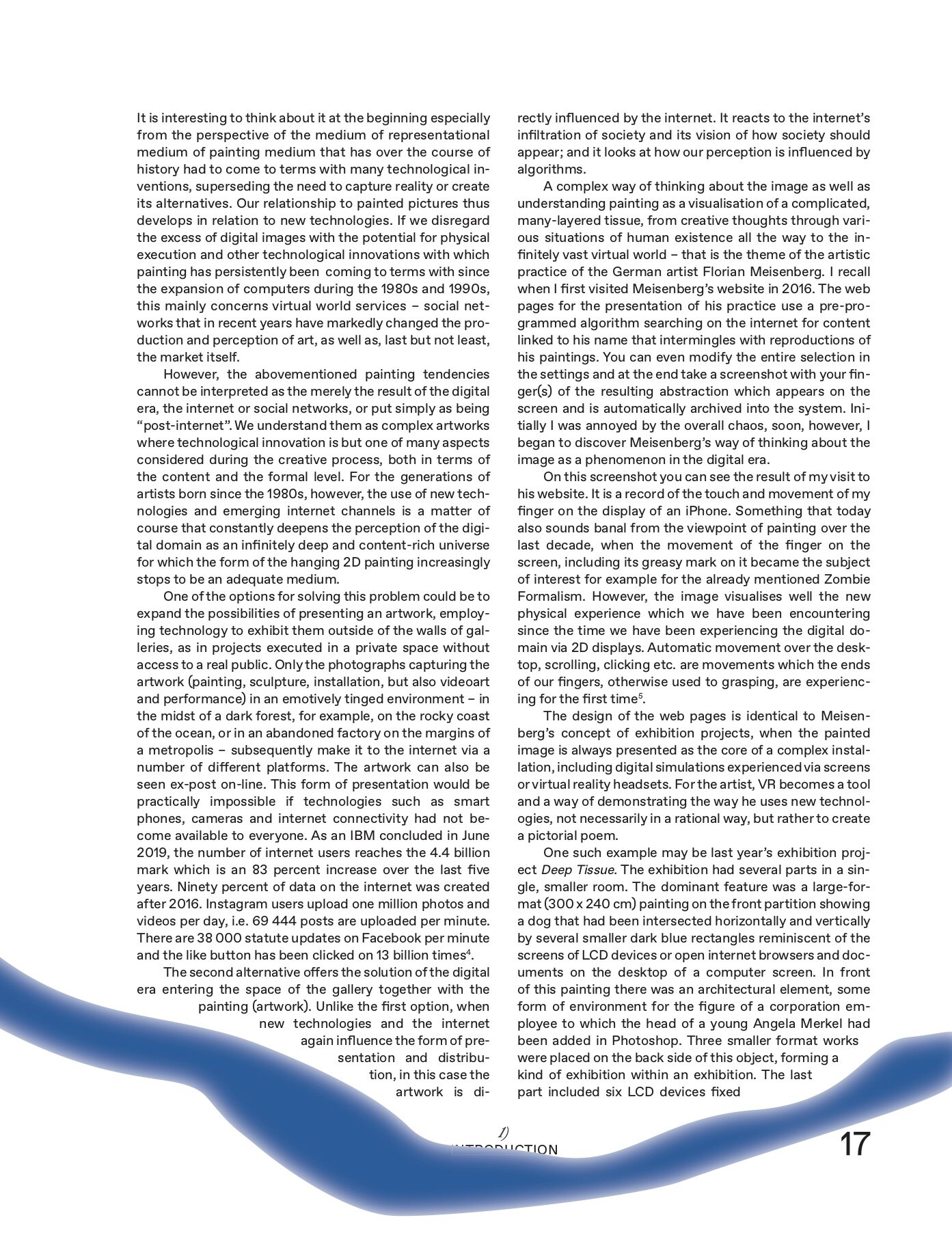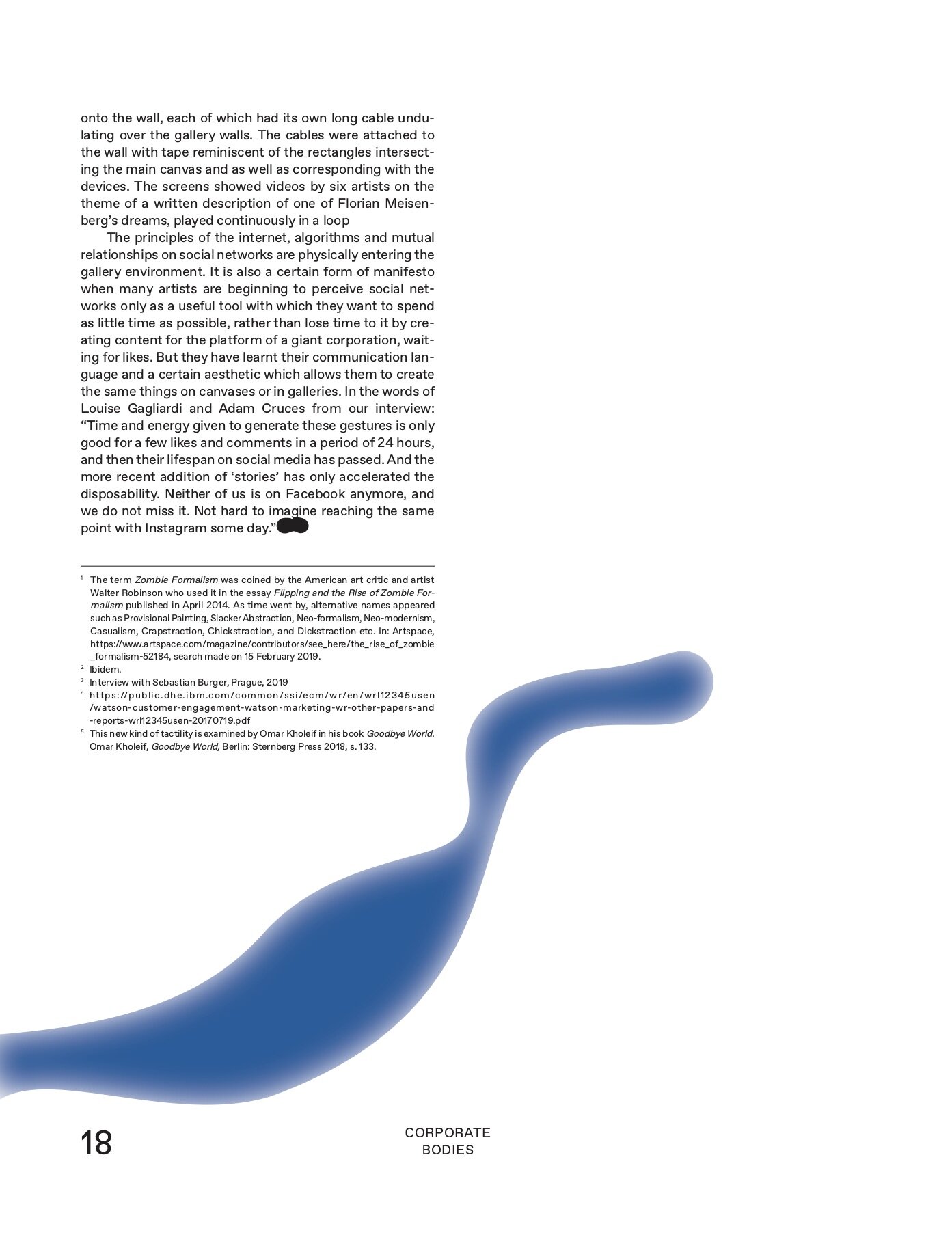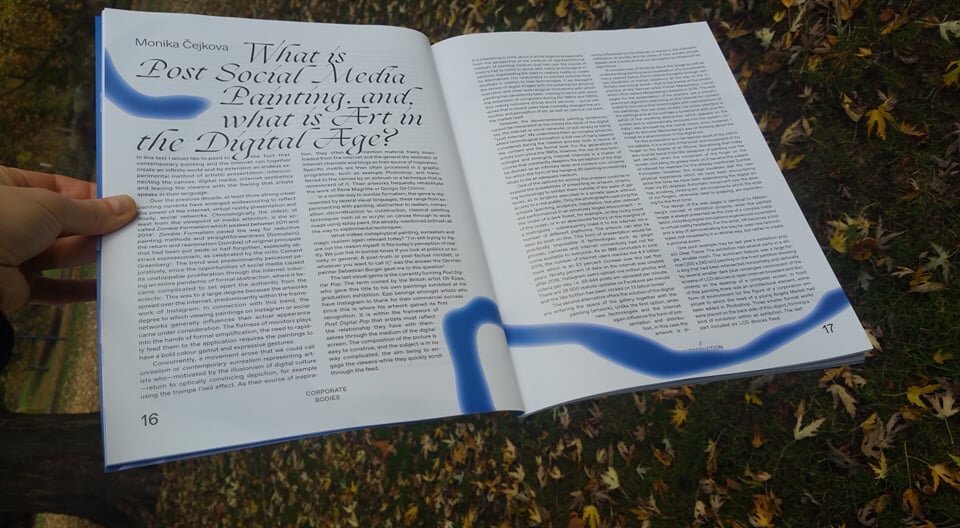Corporate Bodies / Essay: What is the Post Social Media Painting, and, what is Art in the Digital Age?





Essay: What is the Post Social Media Painting, and, what is Art in the Digital Age?
Editor: Ján Gajdušek
Design: Leon Lothschütz
Publisher: PositiF, 2020, Prague, Czech Republic
Pages: 82
Language: English
ISBN: 987–80–87407–30–1
What is
Post Social Media Painting,
and, what is Art
in the Digital Age?
In this text I would like to point to the fact that contemporary painting and the internet can together create an infinite world and by extension an endless experimental method of artistic presentation, interconnecting the canvas, digital media, internet aesthetics and leaving the viewers with the feeling that artists speaks in their language.
Over the previous decade, at least three strong visual painting currents have emerged endeavouring to reflect the phenomenon of the internet, virtual reality presentation and finally, social networks. Chronologically the oldest, at least from the viewpoint of media attention, is the so-called Zombie Formalism which peaked between 2011 and 2014 [1]. Zombie Formalism paved the way for reductive painting methods and straightforwardness (formalism), the return and reanimation (zombie) of original principals that had been put aside or half-forgotten, especially abstract expressionism, as celebrated by the critic Cement Greenberg [2]. The trend was predominantly perceived pejoratively, since the opportunities of social media caused its unstoppable proliferation through the internet inducing an entire pandemic of formal abstraction, where it became complicated to set apart the authentic from the eclectic. This was to a large degree because the artworks spread over the internet, predominantly within the framework of Instagram. In connection with this trend, the degree to which viewing paintings on Instagram or social networks generally influences their actual appearance came under consideration. The flatness of monitors plays into the hands of formal simplification, the need to rapidly feed them to the application requires the paintings to have a bold colour gamut and expressive gestures.
Concurrently, a movement arose that we could call unrealism or contemporary surrealism representing artists who - motivated by the illusionism of digital culture – return to optically convincing depiction, for example using the trompe l’oeil effect. As their source of inspiration, they often mention material freely downloaded from the internet and the general aesthetic of internet channels and blogs as their source of inspiration. Specific motifs are then often processed in a graphic programme, such as Photoshop, and transferred to the canvas by an airbrush or a technique that is reminiscent of it. Their artworks frequently rehabilitate the work of René Magritte or Giorgio De Chirico.
In a similar way to zombie formalism, this genre is represented by several visual languages; these range from experimenting with painting, abstraction to realism, composition deconstruction to construction, classical painting techniques such oil or acrylic on canvas through to work made using spray paint, the already-mentioned airbrush all the way to experimental techniques.
What makes metaphysical painting, surrealism and magic realism again relevant today? “I’m still trying to figure out the reason myself. It fits today’s perception of reality. We just live in surreal times if you look at politics or society in general. A post-truth or post-factual mindset, or whatever you want to call it,” was the answer the German painter Sebastian Burger gave me to this question [3].
The last visual genre is the currently forming Post Digital Pop. The term coined by the British artist Oli Epp, who gave this title to his own paintings exhibited at his graduation show in 2017. Epp belongs amongst artists who have Instagram to thank for their commercial success since this is where his artwork gained its first recognition. It is within the framework of Post Digital Pop that artists most reflect the relationship they have with themselves through the medium of the digital screen. The composition of the picture is easy to construe, and the subject is in no way complicated, the aim being to engage the viewers while they quickly scroll through the feed.
It is interesting to think about it at the beginning especially from the perspective of the medium of representational painting that has over the course of history had to come to terms with many technological inventions, superseding the need to capture reality or create its alternatives. Our relationship to painted pictures thus develops in relation to new technologies. If we disregard the excess of digital images with the potential to be physically produced and other technological innovations with which painting has persistently been coming to terms with since the expansion of computers during the 1980s and 1990s, this mainly concerns virtual world services – social networks that in recent years have markedly changed the production and perception of art, as well as, last but not least, the market itself.
However, the abovementioned painting tendencies cannot be interpreted as merely the result of the digital era, the internet or social networks, or put simply as being “post-internet”. We understand them to be complex artworks where technological innovation is but one of many aspects considered during the creative process, both in terms of the content and the formal level. For the generations of artists born since the 1980s, however, the use of new technologies and emerging internet channels is a matter of course that constantly deepens the perception of the digital domain as an infinitely deep and content-rich universe for which the form of the hanging 2D painting increasingly stops to be an adequate medium.
One of the options for solving this problem could be to expand the possibilities of presenting an artwork, employing technology to exhibit them outside of the walls of galleries, as in projects executed in a private space without access to a real public. Only the photographs capturing the artwork (painting, sculpture, installation, but also video art and performance) in an emotively tinged environment – in the midst of a dark forest, for example, on the rocky coast of the ocean, or in an abandoned factory on the margins of a metropolis – subsequently make it to the internet via a number of different platforms. The artwork can also be seen ex-post on-line. This form of presentation would be practically impossible if technologies such as smart phones, cameras and internet connectivity had not become available to everyone. As an IBM survey concluded in June 2019, the number of internet users reached the 4.4 billion mark which is an 83 percent increase over the last five years. Ninety percent of data on the internet was created after 2016. Instagram users upload one million photos and videos per day, i.e. 69 444 posts go up per minute. There are 38 000 statute updates on Facebook per minute and the like button has been clicked on 13 billion times [4].
The second alternative offers the solution of the digital era entering the space of the gallery together with the painting (artwork). Unlike the first option, when new technologies and the internet again influence the form of presentation and distribution, in this case the artwork is directly influenced by the internet. It reacts to the internet’s infiltration of society and its vision of how society should appear and it looks at how our perception is influenced by algorithms.
A complex way of thinking about the image as well as understanding painting as a visualisation of a complicated, many-layered tissue, from creative thoughts through various existential situations all the way to the infinitely vast virtual world – that is the theme of the practice of the German artist Florian Meisenberg. I recall when I first visited Meisenberg’s website in 2016. The web pages for the presentation of his practice use a pre-programmed algorithm that searches on the internet for content linked to the artist’s name and intermingles with reproductions of his paintings. You can even modify the entire selection in the settings and at the end take a screenshot with your finger(s) of the resulting abstraction which appears on the screen and is automatically archived into the system. Initially, I was annoyed by the overall chaos, but soon, I began to discover Meisenberg’s way of thinking about the image as a phenomenon in the digital era.
On this screenshot you can see the result of my visit to his website. It is a record of the touches and movements of my finger on the display of an iPhone. Something that today sounds banal from the viewpoint of painting over the last decade, when the movement of the finger on the screen, including the greasy mark left on it, became the subject of interest for example for the already mentioned Zombie Formalism. However, the image visualises well the new physical experience which we have been encountering since the time we have been experiencing the digital domain via 2D displays. Automatic movement over the desktop, scrolling, clicking etc. are movements which the ends of our fingers – otherwise used to grasping – are experiencing for the first time [5].
The design of the web pages is identical to Meisenberg’s concept of exhibition projects, when the painted image is always presented as the core of a complex installation, including digital simulations experienced via screens or virtual reality headsets. For the artist, VR becomes a tool and a way of demonstrating the way he uses new technologies, not necessarily in a rational way, but rather to create a pictorial poem.
One such example may be last year’s exhibition project Deep Tissue. The show was in several parts in a single, smaller room. The dominant feature was a large-format (300 x 240 cm) painting on a partition showing a dog that had been intersected horizontally and vertically by several smaller dark blue rectangles reminiscent of the screens of LCD devices or open internet browsers and documents on the desktop of a computer screen. In front of this painting there was an architectural element, some form of environment for the figure of a corporation employee to which the head of a young Angela Merkel had been added in Photoshop. Three smaller format works were placed on the back side of this object, forming a kind of exhibition within an exhibition. The last part included six LCD devices fixed onto the wall, each of which had its own long cable undulating over the gallery walls. The cables were attached to the wall with tape reminiscent of the rectangles intersecting the main canvas as well as reciprocating the devices. The screens showed videos by six artists on the theme of a written description of one of Florian Meisenberg’s dreams, played continuously in a loop.
Installation Views of Florian Meisenberg‘s Deep Tissue at Berlínskej model, 2019
The principles of the internet, algorithms and mutual relationships on social networks are physically entering the gallery environment. It is also in a way a manifesto for many artists are beginning to perceive social networks only as a useful tool, on which they want to spend as little time as possible, rather than lose time by creating content for the platform of a giant corporation, waiting for likes. But they have learnt their communication language and a certain aesthetic which allows them to create the same things on canvases or in galleries. In the words of Louise Gagliardi and Adam Cruces from our interview: “Time and energy given to generate these gestures is only good for a few likes and comments in a period of 24 hours, and then their lifespan on social media has passed. And the more recent addition of ‘stories’ has only accelerated the disposability. Neither of us is on Facebook anymore, and we do not miss it. Not hard to imagine reaching the same point with Instagram some day.”
1 The term Zombie Formalism was coined by the American art critic and artist Walter Robinson who used it in the essay Flipping and the Rise of Zombie Formalism published in April 2014. As time went by, alternative names appeared such as Provisional Painting, Slacker Abstraction, Neo-formalism, Neo-modernism, Casualism, Crapstraction, Chickstraction, and Dickstraction etc. In: Artspace, https://WWW.artspace.com/magazine/contributors/see_here/the_rise_of_zombie _formalism-52184, search made on 15 February 2019.
2 Ibidem.
3 Interview with Sebastian Burger, Prague, 2019
4 https://public.dhe.ibm.com/common/ssi/ecm/wr/en/wrl12345usen/watson-customer-engagement-watson-marketing-wr-other-papers-and-reports-wrl12345usen-20170719.pdf
5 This new kind of tactility is examined by Omar Kholeif in his book Goodbye World.
Omar Kholeif, Goodbye World, Berlin: Sternberg Press 2018, s. 133.





